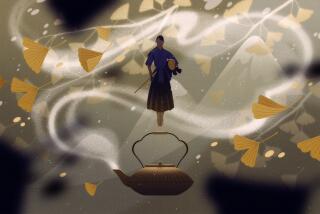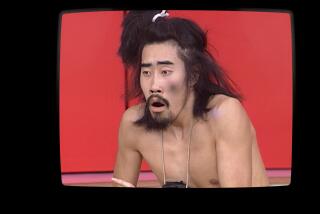From Bhutan to Hollywood
- Share via
So, you’re one of the most important lamas in the Tibetan Buddhist tradition, who at age 7 was recognized as the incarnation of the great religious reformer and saint Jamyang Khyentse Wangpo. In your native land, the Kingdom of Bhutan, you count among your mentors the 14th Dalai Lama. Not only do you oversee various Buddhist monasteries and monks in your domain but you spend several months each year on a strict meditation retreat.
Then the filmmaking bug bites you, and nothing is ever quite the same again--not for you, not for the monks and not for Bhutan, a country roughly the size of Switzerland nestled along the border of Tibet and India in what is one of the world’s most remote regions.
Meet Khyentse Norbu, who at age 38 has taken on another title to go with lama: movie director.
Norbu has just directed “The Cup,” which has the distinction of being the first feature-length movie ever made in Bhutan. With a cast mainly drawn from members of the Chokling Monastery, located in the foothills of the Himalayas, “The Cup” tells the surprisingly comic tale of a group of young Tibetan Buddhist monks living in a remote monastery in India who get caught up in World Cup soccer fever during the summer of 1998.
Fine Line Features, which purchased the rights to Norbu’s film at this year’s Cannes Film Festival, plans to initially release “The Cup” on Jan. 28 in Los Angeles and New York. It has also been entered for Academy Award consideration in the best foreign language film category since the film opened earlier this year at one of Bhutan’s three movie theaters--ticket price: 12 cents.
The key story line in the film revolves around how the soccer-crazed monks collect all their money--including one young monk poignantly handing over a watch given to him by his mother--in hopes of renting a satellite dish so they can catch the World Cup final.
Rich in detail, yet often irreverent in tone, the film takes moviegoers on an eye-opening journey inside a Tibetan Buddhist monastery, where young monks post magazine cutouts of their favorite soccer stars on the walls of their spartan rooms; where boredom causes them to play games or fall asleep during class; and where some take great glee in poking fun at their fellow Tibetans for not bathing regularly.
In Los Angeles recently for a visit--before he headed back to Bhutan for a six-week retreat--Norbu explained that “The Cup” was based on real events that he experienced over the years living in and around Buddhist monasteries. He hoped that the film would dispel the impression, widely held in the West, that Tibetan monks are perfect.
“People think that Tibetan Buddhist monks are like God,” Norbu said. “That is not true. They are human beings who are trying to attain god-like status.”
The film also carries a larger message, exploring the inevitable clash of cultures as the technical marvels of the looming 21st century gradually seep into the tradition-bound monks’ cloistered environment. In one humorous scene, the monks become so rowdy while watching the soccer match that local villagers toss them out the door, telling them not to bother coming back.
“You might say, football is their religion and Buddhism is their philosophy,” Norbu said with a smile.
*
To understand why it has taken tiny Bhutan until the end of the 20th century to mount its first foray into feature-length cinema, some basic understanding of the country is required. Bhutan remained virtually cut off from the Western world until 1974, when the new monarch, Jigme Dorje Wangchuck, invited the international media to cover his coronation. He then opened the doors of his kingdom to paying tourists.
Although Bhutan has its own national airline, Druk Air, the capital city, Thimphu, has no traffic lights and the general public only began getting telephones about five years ago. For anyone venturing into this pristine, mountainous monarchy, travel guides deliver some curious do’s and don’ts, like do walk clockwise around chortens, mani stones, prayer flags and other religious artifacts, and don’t haggle over prices.
Before Norbu could even start production on his film, he found that the nearest 16mm camera for rent was available in Australia--a 14-hour flight away.
“Then to get the camera to the monastery,” Norbu explained, “takes six days of driving.”
Wearing a maroon-colored robe, the youthful-looking lama sat for a recent interview in a sunny garden patio at the Four Seasons Hotel in Beverly Hills, seemingly light-years away from Bhutan. Asked how he liked it in Hollywood, he replied with wry humor: “I would rather go to Budapest or Prague. I like their buildings.”
He was surprisingly candid about his lot in life. After all, it isn’t everyone who as a child is proclaimed the reincarnation of a famous spiritual leader.
“It’s not like it’s any big honor to me,” Norbu said with a shrug. “Sometimes it’s a bit of a hassle.” Besides, he added, “I don’t believe I am the reincarnation of this saint.” But if those who chose him believe him to be, then so be it.
And, when asked to name his favorite American movie, he didn’t hesitate: Oliver Stone’s “Natural Born Killers.”
While it might seem odd that a Buddhist lama would select a film roundly criticized for containing excessive violence as his favorite American movie, Norbu explained that the film “really brings you reality” and reminded him that as a human being, “I have the potential for anger and violence.”
*
Although he never attended film school, Norbu acquired his first film apprenticeship under Italian director Bernardo Bertolucci, serving as a technical consultant on Bertolucci’s 1993 epic film, “Little Buddha.” Norbu soon became enamored by the works of such filmmakers as Yasujiro Ozu, Andrei Tarkovsky and Satyajit Ray and, in 1995, he made a 24-minute film about village life in Bhutan called “Ette Metto.”
But the desire burned inside him to make a feature-length movie. He calculated that it would take about $80,000 to make “The Cup,” money he just didn’t have.
“I tried to mortgage some of my things, but it didn’t work,” he recalled. His worldly possessions--some land, his books, even a necklace given him by his mother--came to only $35,000. “It was beyond me,” he recalled.
Then fortune smiled. On a trip to London, Norbu showed his screenplay to one of the producers he had met on “Little Buddha.” The producer, in turn, sent Norbu’s manuscript to Hooman Majd of Palm Pictures in New York, who immediately agreed to finance the film.
After seeing the early rushes, the producers agreed to kick the budget up to $500,000.
Mark Ordesky, the president of Fine Line Features, first saw the movie when it premiered at Cannes in May.
“I literally fell in love with it,” he recalled. “I saw it in this theater at Cannes where the air-conditioning was out. I could even feel the sweat dripping down my back and I thought surely everyone would fall asleep, but nobody did. There is a magic to this film and a spiritual power, as well as humanism and humor.”
A bidding war quickly erupted over the film at Cannes. Ordesky recalled that Norbu had worked as a technical consultant on Bertolucci’s “Little Buddha.” It just so happened that Fine Line had released another Bertolucci film, “Besieged.” So Ordesky called the famed director and said, “It would mean a lot to me if you made a call to the filmmaker.”
“I know he called, whether it was the director or the producers, I don’t know,” Ordesky said. “The bottom line was, we made the deal. Bertolucci’s name carries a lot of weight in the Buddhist world.”
Last summer, Fine Line screened the film at the Toronto Film Festival, where it placed runner-up for the audience award behind the major Hollywood release “American Beauty.”
*
Ordesky said now the task for Fine Line is to gain recognition for the film in hopes of getting Academy Award or Golden Globe nominations. Earlier this week, the academy formally accepted “The Cup” as the official entry from Bhutan in the best foreign language film category. It is among a record 47 countries that have submitted films this year, including other first-time competitors Nepal and Tadjikistan.
Casting the film proved easier than the financing.
For the role of Orgyen, the football-obsessed teenage monk, Norbu chose 13-year-old Jamyang Lodro, who wrangled a trip to Disneyland from the director in return for his acting services. Norbu said the boy reminded him a lot of his own youth.
“He was wild, impulsive, cheeky--quite outstanding,” the director noted. Born and raised in a Tibetan refugee settlement, the boy continues to study at the Buddhist school in the Chokling Monastery.
The abbot’s frazzled right-hand man, Geko, was portrayed by Orgyen Tobgyal, who in real life is chief preceptor of Chokling Monastery. Other principal actors included Neten Chokling (Lodo), recognized as the fourth reincarnation of the great Buddhist master Chogyur Dechen Lingpa; Kunzang Nyima (Palden), a Tibetan villager who crossed the Himalayas, escaping from Tibet into northern India barely two weeks before production got underway; and, Lama Chonjor (the abbot), the real-life abbot of the Chokling Monastery who, after completion of principal photography, fulfilled his dream and returned to Tibet.
Then there is Godu Lama, a highly respected yet eccentric yogi who plays an old, fortuneteller in the film.
In real life, Norbu said of Godu Lama, “he can always be found in a bar or a dice room. He’s a great teacher who monks love,” noting that the yogi had never washed his hair until he did so for a scene in the film.
Asked how he would feel if, somehow, “The Cup” were ever to win an Academy Award, Norbu said he’d gladly accept it after first examining himself and telling his pride and ego, “Be calm.”
More to Read
Only good movies
Get the Indie Focus newsletter, Mark Olsen's weekly guide to the world of cinema.
You may occasionally receive promotional content from the Los Angeles Times.










